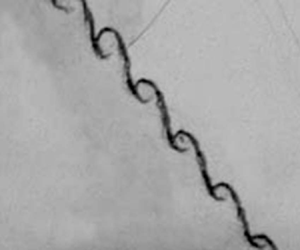Article contents
Coupled Richtmyer–Meshkov and Kelvin–Helmholtz instability on a shock-accelerated inclined single-mode interface
Published online by Cambridge University Press: 02 October 2024
Abstract

The coupling of Richtmyer–Meshkov instability (RMI) and Kelvin–Helmholtz instability (KHI), referred to as RM-KHI, on a shock-accelerated inclined single-mode air–SF $_6$ interface is studied through shock-tube experiments, focusing on the evolution of the perturbation distributed along the inclined interface. To clearly capture the linear (overall linear to nonlinear) evolution of RM-KHI, a series of experiments with a weak (relatively strong) incident shock is conducted. For each series of experiments, various
$_6$ interface is studied through shock-tube experiments, focusing on the evolution of the perturbation distributed along the inclined interface. To clearly capture the linear (overall linear to nonlinear) evolution of RM-KHI, a series of experiments with a weak (relatively strong) incident shock is conducted. For each series of experiments, various  $\theta _{i}$ (angle between incident shock and equilibrium position of the initial interface) are considered. The nonlinear flow features manifest earlier and develop faster when
$\theta _{i}$ (angle between incident shock and equilibrium position of the initial interface) are considered. The nonlinear flow features manifest earlier and develop faster when  $\theta _{i}$ is larger and/or shock is stronger. In addition, the interface with
$\theta _{i}$ is larger and/or shock is stronger. In addition, the interface with  $\theta _{i}>0^{\circ }$ evolves obliquely along its equilibrium position under the effect of KHI. RMI dominates the early-time amplitude evolution regardless of
$\theta _{i}>0^{\circ }$ evolves obliquely along its equilibrium position under the effect of KHI. RMI dominates the early-time amplitude evolution regardless of  $\theta _{i}$ and shock intensity, which arises from the discrepancy in the evolution laws between RMI and KHI. KHI promotes the post-early-stage amplitude growth and its contribution is related positively to
$\theta _{i}$ and shock intensity, which arises from the discrepancy in the evolution laws between RMI and KHI. KHI promotes the post-early-stage amplitude growth and its contribution is related positively to  $\theta _{i}$. An evident exponential-like amplitude evolution behaviour emerges in RM-KHI with a relatively strong shock and large
$\theta _{i}$. An evident exponential-like amplitude evolution behaviour emerges in RM-KHI with a relatively strong shock and large  $\theta _{i}$. The linear model proposed by Mikaelian (Phys. Fluids, vol. 6, 1994, pp. 1943–1945) is valid for RM-KHI within the linear period. In contrast, the adaptive vortex model (Sohn et al., Phys. Rev. E, vol. 82, 2010, p. 046711) can effectively predict both the interface morphology and overall amplitude evolutions from the linear to nonlinear regimes.
$\theta _{i}$. The linear model proposed by Mikaelian (Phys. Fluids, vol. 6, 1994, pp. 1943–1945) is valid for RM-KHI within the linear period. In contrast, the adaptive vortex model (Sohn et al., Phys. Rev. E, vol. 82, 2010, p. 046711) can effectively predict both the interface morphology and overall amplitude evolutions from the linear to nonlinear regimes.
JFM classification
Information
- Type
- JFM Papers
- Information
- Copyright
- © The Author(s), 2024. Published by Cambridge University Press
References
- 2
- Cited by


